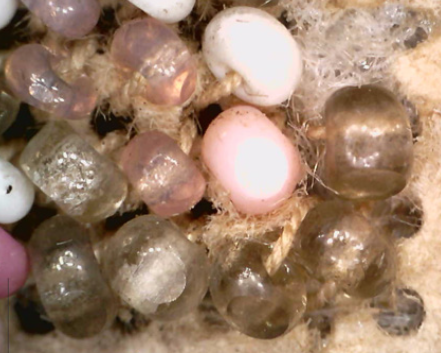Conservation intervention on an embroidery with beads on perforated cardboard: problems and solutions
DOI:
https://doi.org/10.14568/cp2018072Keywords:
Perforated cardboard, Embroidery, Glass beads, Micro-consolidation, Micro-infillAbstract
Perforated cardboard is a rigid material widely used during the second half of the 19th century as an embroidery support, but very little-known today. Intervention cases are rare, and so an intervention on a poor condition 1879 glass beads embroidered specimen is presented here. The intervention was a complex task, mainly due to the fragility of the object and the existence of different materials linked to each other, that did not allow the execution of treatments to which they are usually subjected when isolated. The most intricate operation was the simultaneous action of micro-consolidation and micro-infill. These involved the insertion of Japanese paper fibres and 4 % Tylose MH300 between the perforated paper layers, and the insertion of Japanese paper strips between the embroidery lines. For the embroidery housing, it was necessary simultaneously to avoid the most unfavourable conditions for both the preservation of the glass and the paper.
Received: 2018-12-9
Revised: 2019-1-28
Accepted: 2019-2-13
Online: 2019-3-7
Publication: 2020-7-31
Downloads
References
[1] Barros, L.; Cruz, A. J.; Loureiro, L., 'Perforated cardboards: a review, based on 19th century sources, of a raw material used in many everyday Victorian objects', Restaurator (no prelo), https://doi.org/10.1515/res-2018-0021.
[2] Lister, A.; Fairbrass, S., 'Necessary compromise: treatment strategies for composite objects', in Proceedings of the Fourth International Conference of the Institute of Paper Conservation, ed. J. Eagan, Institute of Paper Conservation, Leigh (1998) 264-272.
[3] Ilvessalo-Pfäffli, M.-S., Fiber Atlas Identification of Papermaking Fibers, Springer, Berlin (1995).
[4] García Hortal, J. A., Constituyentes Fibrosos de Pastas y Papeles. Morfología, Análisis Microscópico, Universitat Politècnica de Catalunya, Terrassa (1993), http://hdl.handle.net/2099.3/36484.
[5] Browning, B. L., Analysis of Paper, 2.ª ed., Marcel Dekker, New York (1977).
[6] Ohern, R.; McHugh, K., 'Deterioration and conservation of unstable glass beads on native american objects', The Bead Forum. Newsletter of the Society of Bead Researchers 63 (2013) 1-13.
[7] Kistler, C. D., 'A collector's history of perforated paper needlework', Dutch Treat Designs, (2012), http://www.dutchtreat.com/perfpaper/perf_article_2012.pdf.
[8] Vincent, M., The Ladies Work Table. Domestic Needlework in Nineteenth-Century America, Allentown Art Museum, Allentown (1988).
[9] Kidd, K. E.; Kidd, M. A., 'A classification system for glass beads for the use of field archaeologists', Canadian Historic Sites: Occasional Papers in Archaeology and History 1 (1970) 46-97.
[10] Citrigno, J.-A., 'Needle Arts in Nova Scotian Women's Lives 1752-1938', Nova Scotia Museum, (1998), https://ojs.library.dal.ca/NSM/article/view/4073.
[11] Sequeira, S. O.; Carvalho, H. P. d.; Mesquita, N.; Portugal, A.; Macedo, M. F., 'Fungal stains on paper: is what you see what you get?', Conservar Património (no prelo), https://doi.org/10.14568/cp2018007.
[12] Davison, S., Conservation and Restoration of Glass, 2.ª ed., Butterworth-Heinemann, Oxford (2003).
[13] Muñoz-Viñas, S., 'Minimal intervention revisited', in Conservation. Principles, Dilemmas and Uncomfortable Truths, ed. A. Richmond & A. Bracker, Butterworth-Heinemann, Oxford (2009) 47-59.
[14] Abdel-Kareem, O., 'Microbiological testing to assess the susceptibility of museum textiles conserved with polymers to fungal deterioration', in Polymer Science: Research Advances, Practical Applications and Educational Aspects, ed. A. Méndez-Vilas & A. Solano, Formatex Research Center, Badajoz (2016) 309-320.
[15] Swift, R.; Meek, A. S.; Rode, N.; Komlosy, A., 'A radioactive shamanic apron with glass disease', The British Museum Technical Research Bulletin 6 (2012) 25-32.
[16] Muñoz Viñas, S., La Restauración del Papel, Editorial Tecnos, Madrid (2010).
[17] Koob, S. P., 'Cleaning glass: a many-faceted issue', in Objects Specialty Group Postprints, ed. V. Greene & P. Griffin, The American Institute for Conservation of Historic & Artistic Works, Washington (2004) 60-70.
[18] Lovell, A., 'Glass Bead Deterioration of Ethnographic Objects: Identification, Prevention, and Treatment', tese, John F. Kennedy University, (2006).

Downloads
Published
How to Cite
Issue
Section
Categories
License
This work is distributed under a Creative Commons Attribution License (CC BY-NC-ND 4.0) which permits use, distribution, and reproduction in any medium following no commercial or derivatives, provided the original author and source are credited.
Copyright remains with the authors.






